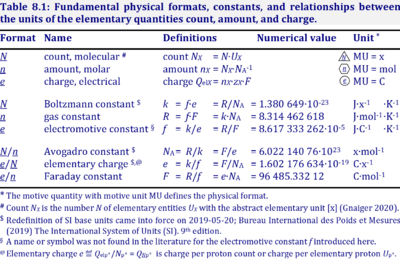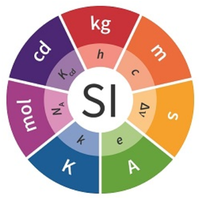Description
The Avogadro constant, NA, has the SI unit 'per mole' [mol-1] (IUPAC), but more strictly the unit for counting entities per amount is 'units per mole' [x·mol-1] (compare elementary charge). Therefore, the reciprocal of the Avogadro constant is the proportionality factor between the amount of substance and the number of specified elementary entities of that substance, or 'count per amount' with units 'counting units per mole'. The Avogadro constant times elementary charge is the Faraday constant.
Abbreviation: NA [x·mol-1]
Reference: Gibney 2017 Nature
Communicated by Gnaiger Erich 2018-10-18, last update 2020-05-19
Discussion
- In a critical article on dimensionless units in the SI, Mohr and Phillips (2015) comment on the Avogadro constant, NA: "Evidently, this constant can be viewed as the conversion factor between entities and moles." The unit mole [mol], however, is the SI base unit for amount of substance, defined by IUPAC (Cohen et al 2008) as: "Amount of substance is proportional to the number of specified elementary entities of that substance". Therefore, NA is not the conversion factor between entities and moles, but NA is the conversion factor between count and amount, expressed in counting units of entities and moles of entities. Thus, the unit 'ent' suggested by Mohr and Phillips (2015) for the quantity count would imply, that they should consider 'mol ent' as the unit for amount of substance. In this case, the unit of NA should be [ent/(mol ent) = mol-1], in line with SI, but contrary to the valid intention of Mohr and Phillips (2015).
- NA is the conversion factor between countable entities, expressed in counting units [x], and amount of entities (amount of substance), expressed in moles [mol]. Therefore, the unit of NA is 'counting units per mole' [x·mol-1].
References
| Bioblast link | Reference | Year |
|---|---|---|
| Brown 2018 Metrologia | Brown RJC (2018) The evolution of chemical metrology: distinguishing between amount of substance and counting quantities, now and in the future. Metrologia 55:L25. https://doi.org/10.1088/1681-7575/aaace8 | 2018 |
| Brown 2021 Metrologia | Brown RJC (2021) A metrological approach to quantities that are counted and the unit one. Metrologia 58:035014. https://doi.org/10.1088/1681-7575/abf7a4 | 2021 |
| Bureau International des Poids et Mesures 2019 The International System of Units (SI) | Bureau International des Poids et Mesures (2019) The International System of Units (SI). 9th edition:117-216. ISBN 978-92-822-2272-0 | 2019 |
| Cohen 2008 IUPAC Green Book | Cohen ER, Cvitas T, Frey JG, Holmström B, Kuchitsu K, Marquardt R, Mills I, Pavese F, Quack M, Stohner J, Strauss HL, Takami M, Thor HL (2008) Quantities, Units and Symbols in Physical Chemistry. IUPAC Green Book 3rd Edition, 2nd Printing, IUPAC & RSC Publishing, Cambridge. | 2008 |
| Cooper 2012 Synthese | Cooper G, Humphry SM (2012) The ontological distinction between units and entities. Synthese 187:393–401. https://doi.org/10.1007/s11229-010-9832-1 | 2012 |
| Gibney 2017 Nature | Gibney E (2017) New definitions of scientific units are on the horizon. Nature 550:312–13. | 2017 |
| Gnaiger 2020 BEC MitoPathways | Gnaiger E (2020) Mitochondrial pathways and respiratory control. An introduction to OXPHOS analysis. 5th ed. Bioenerg Commun 2020.2. https://doi.org/10.26124/bec:2020-0002 | 2020 |
| Gnaiger 2020 MitoFit x | Gnaiger E (2021) The elementary unit — canonical reviewer's comments on: Bureau International des Poids et Mesures (2019) The International System of Units (SI) 9th ed. https://doi.org/10.26124/mitofit:200004.v2 | 2021 |
| Mohr 2015 Metrologia | Mohr Peter J, Phillips William D (2015) Dimensionless units in the SI. Metrologia 52:40-7. https://doi.org/10.1088/0026-1394/52/1/40 | 2015 |
- Bioblast links: SI base units - >>>>>>> - Click on [Expand] or [Collapse] - >>>>>>>
- Entity, count, and number, and SI base quantities / SI base units
Quantity name Symbol Unit name Symbol Comment elementary UX elementary unit [x] UX, UB; [x] not in SI count NX elementary unit [x] NX, NB; [x] not in SI number N - dimensionless = NX·UX-1 amount of substance nB mole [mol] nX, nB electric current I ampere [A] A = C·s-1 time t second [s] length l meter [m] SI: metre mass m kilogram [kg] thermodynamic temperature T kelvin [K] luminous intensity IV candela [cd]
- Fundamental relationships
- » Avogadro constant NA
- » Boltzmann constant k
- » elementary charge e
- » Faraday constant F
- » gas constant R
- » electrochemical constant f
- Fundamental relationships
- SI and related concepts
MitoPedia concepts:
Ergodynamics



